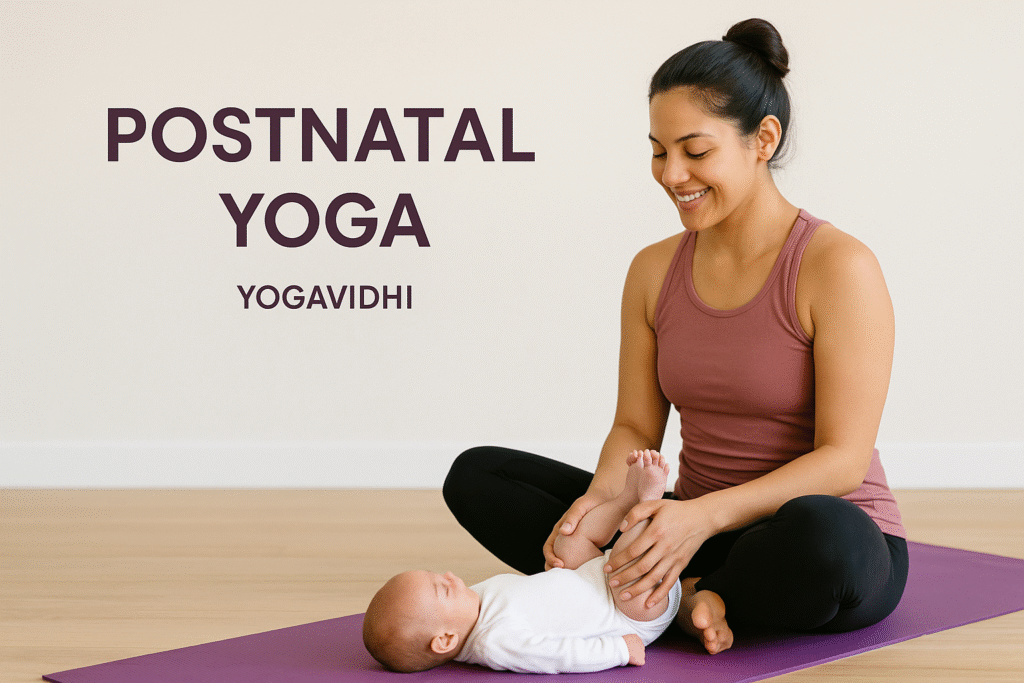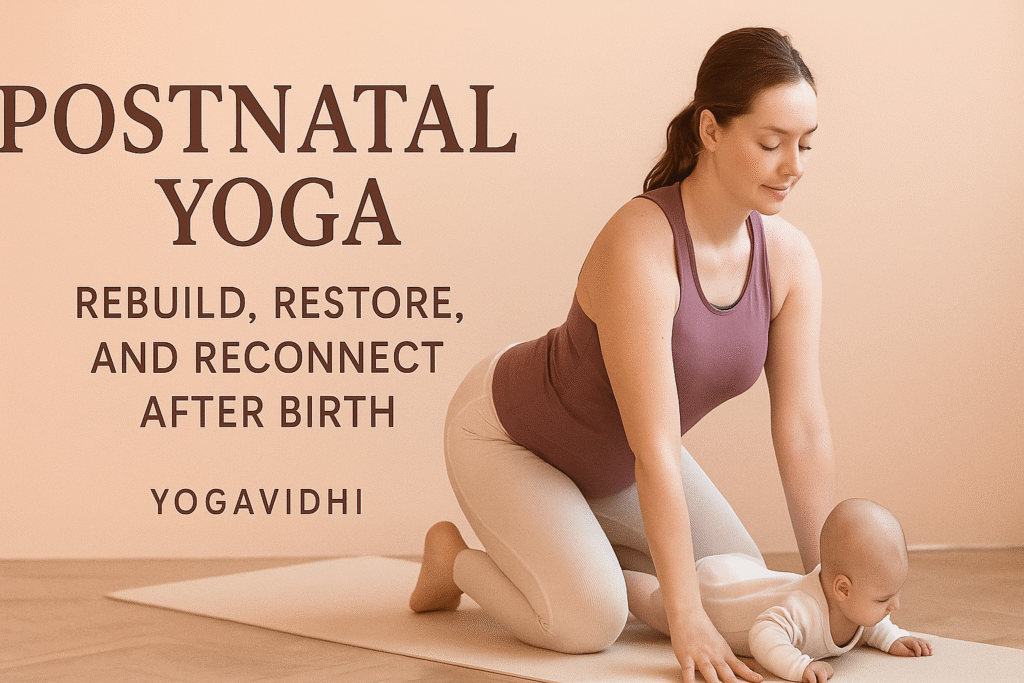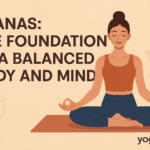Welcoming a new baby into the world is a transformative experience—beautiful, overwhelming, and often exhausting. As joyful as motherhood is, it also places immense physical, emotional, and mental demands on your body. That’s where Postnatal Yoga comes in—a gentle, empowering way to heal, reconnect, and restore balance during the postpartum journey.
In this guide, you’ll discover how postnatal yoga can support your recovery, boost your emotional wellbeing, and help you build a strong, loving bond with your baby—all while gently guiding you back to your body.
Postnatal yoga, or postpartum yoga, is a gentle form of exercise tailored for new mothers to support recovery after childbirth. It emphasizes light stretching, breathing techniques, and core-strengthening movements to aid healing, restore physical strength, and alleviate stress and anxiety.
Table of Contents
What Is Postnatal Yoga?
Postnatal yoga, also called postpartum yoga, is a specialized form of yoga designed specifically for mothers who have recently given birth. Unlike prenatal yoga, which focuses on preparing your body for labor and delivery, postnatal yoga emphasizes healing, rehabilitation, and emotional support after childbirth.
This practice involves gentle stretches, breathing exercises, pelvic floor work, core strengthening, and restorative poses that aid in the body’s natural recovery process.
Whether you’ve had a natural delivery or a cesarean section, yoga after delivery offers safe, structured ways to regain strength, improve posture, and release tension—all while embracing the profound changes of motherhood.
The Powerful Benefits of Postnatal Yoga
Healing after childbirth is more than just physical recovery—it’s also about mental and emotional restoration. Here’s how postnatal yoga benefits you in multiple ways:
1. Strengthens the Core and Pelvic Floor
Pregnancy and labor stretch and weaken your abdominal muscles and pelvic floor. Postnatal yoga offers targeted movements that gently rebuild strength, especially to prevent or heal diastasis recti and reduce incontinence.
2. Improves Posture
New mothers often spend hours nursing, rocking, or carrying their babies—leading to rounded shoulders, back pain, and neck stiffness. Yoga helps open the chest, realign the spine, and strengthen the back muscles.
3. Eases Stress and Anxiety
The postpartum period can be emotionally overwhelming. Through deep breathing and mindfulness, postnatal yoga activates your parasympathetic nervous system, reducing cortisol levels and helping you feel calmer and more centered.
4. Enhances Sleep Quality
While sleep with a newborn is never guaranteed, regular yoga practice can help improve your ability to fall asleep faster and feel more rested—especially when paired with relaxation-based poses like Legs-Up-the-Wall and Child’s Pose.
5. Rebuilds Body Confidence
Postpartum bodies change—and that’s okay. Postnatal yoga helps you reconnect with your body, honor its strength, and let go of unrealistic expectations, fostering self-love and acceptance.
When and How to Start Postnatal Yoga Safely
Safety always comes first, especially after childbirth. Before beginning any postnatal yoga routine, consult your healthcare provider. In general:
- Vaginal delivery recovery: Wait 6 weeks (or as advised)
- Cesarean section recovery: Wait 8–12 weeks (with clearance)
- If complications occurred: Follow your doctor’s specific guidance
Start slowly. Your first few sessions might focus only on breathwork and gentle stretches. The goal is not perfection—it’s progress and presence.
Key Tips:
- Use props like bolsters, pillows, or blocks for extra support.
- Focus on low-impact, breath-centered poses.
- Avoid deep backbends or intense core exercises until fully healed.
- Listen to your body—never push through pain.
Top Postnatal Yoga Poses to Try
Here are some beginner-friendly, effective yoga poses after delivery that support your recovery and promote relaxation:
1. Cat-Cow Stretch (Bitilasana/Marjaryasana)
Improves spinal mobility and strengthens abdominal muscles.
- Start on all fours.
- Inhale: arch your back, gaze up.
- Exhale: round your spine, tuck your chin.
2. Bridge Pose (Setu Bandhasana)
Strengthens glutes and pelvic floor.
- Lie on your back with knees bent.
- Press feet into the mat and lift your hips.
- Engage your core and breathe deeply.
3. Child’s Pose (Balasana)
Gently stretches hips and relieves stress.
- Kneel on the mat, sit back on your heels.
- Extend arms forward and rest your forehead down.
- Breathe slowly and deeply.
4. Legs-Up-the-Wall (Viparita Karani)
Promotes circulation and deep relaxation.
- Lie on your back near a wall.
- Swing your legs up the wall and rest.
- Perfect for 5–10 minutes of restoration.
5. Reclined Bound Angle Pose (Supta Baddha Konasana)
Opens hips and calms the nervous system.
- Lie down, bring soles of feet together, let knees drop to the sides.
- Support knees with cushions if needed.
- Breathe into your belly.
These poses can be safely practiced a few times per week, even if you only have 10–15 minutes.
Read More: Yoga Courses: Find the Right Path to Your Wellness Journey
Read More: Prenatal Yoga: A Gentle Path to a Healthier, Happier Pregnancy
| Section | Details |
| What is Postnatal Yoga? | A gentle yoga practice designed for mothers after childbirth to aid recovery. |
| When to Start | – 6 weeks post vaginal delivery – 8–12 weeks post C-section (with clearance) |
| Core Benefits | – Pelvic floor & core strength – Improved posture – Reduced stress & anxiety – Better sleep – Emotional balance |
| Top Poses | – Cat-Cow Stretch – Bridge Pose – Child’s Pose – Legs-Up-the-Wall – Reclined Bound Angle |
| How Often to Practice | 2–3 times a week; even 10–15 minutes daily is beneficial |
| Props Needed | Yoga mat, pillows, blanket, optional bolster or block |
| Online Class Options | YouTube, Glo, Yoga with Adriene, Mommy Yoga apps |
| Can Include Baby? | Yes – Mommy-and-me yoga helps bond with baby and supports recovery |
| Common Challenges | Fatigue, time constraints, low motivation, healing limitations |
| Tips for Success | – Start small – Use breathwork – Practice during nap times – Create a cozy yoga space |
Including Your Baby in Your Yoga Practice
Mommy and Me yoga is a beautiful way to bond with your baby while gently easing back into movement. Many postnatal yoga classes now incorporate infant-friendly poses or time for connection.
Ideas for Practicing Yoga with Baby:
- Place baby on a mat in front of you during stretches.
- Gently incorporate baby into poses like Cobra or Seated Forward Bend.
- Use soothing music and mirror your breath with theirs.
Always ensure your baby is supported, calm, and supervised during your practice. Remember, it’s okay to pause, cuddle, or feed during your session.
Finding Postnatal Yoga Classes (Online & In-Person)
Whether you prefer in-person guidance or the flexibility of home practice, there are many ways to access postnatal yoga classes today.
In-Studio Options:
- Look for yoga studios with specialized postnatal or Mommy & Me classes.
- Ensure the instructor is trained in postpartum care.
Online Yoga for New Moms:
- YouTube channels and apps like Glo, Yoga with Adriene, or Mommy Yoga offer accessible classes.
- Choose short, targeted sessions focused on pelvic floor recovery, gentle flow, or stress relief.
Consistency matters more than intensity. Even 10 minutes daily can make a meaningful difference in your healing journey.
Common Challenges and How to Overcome Them
Let’s be real: it’s not always easy to roll out the mat when you’re sleep-deprived, healing, and adjusting to a newborn. But the beauty of postnatal yoga lies in its flexibility and compassion.
Common Barriers:
- Fatigue: Choose restorative poses when energy is low.
- Time constraints: Practice in short 5–10 minute windows.
- Motivation: Remind yourself it’s not just about fitness—it’s self-care.
- Insecurity: Trust your body and take things at your own pace.
Pro Tip: Set up a cozy yoga corner at home with a mat, blanket, and bolster. That inviting space becomes your personal oasis.
Creating a Sustainable Postnatal Yoga Routine
Forming a realistic, nourishing routine is key to long-term benefits. Here’s how:
- Start small: Aim for 2–3 days per week and increase gradually.
- Pair with baby’s nap time: Find short pockets of calm in your day.
- Use guided videos: They offer structure and support.
- Mix in breathwork: Even 5 minutes of deep breathing counts.
- Celebrate progress: Healing is not linear—honor every step.
Remember, yoga is more than movement. It’s mindfulness, breathing, and simply being present in your body.

Real Stories: How Postnatal Yoga Changed Lives
“I had back pain and felt disconnected after my C-section. Postnatal yoga gave me the tools to heal at my own pace. It reminded me that I am strong, even when tired.”
— Nisha, Mom of 1
“Yoga became my sanctuary. Those 15 minutes of breathing and stretching gave me peace when everything else felt chaotic.”
— Aanya, Mom of twins
Final Thoughts: Embrace Your Postpartum Journey with Grace
Postnatal yoga isn’t just about getting your “pre-baby body” back. It’s about honoring your journey, embracing transformation, and showing yourself compassion.
Whether you’re healing from childbirth, navigating sleepless nights, or simply craving a moment of stillness, postnatal yoga offers a gentle, grounding path back to yourself.
You are healing. You are growing. And you deserve to feel whole—mind, body, and spirit.
Frequently Asked Questions (FAQ):
Q. When can I start postnatal yoga after giving birth?
Ans: Generally, 6 weeks after vaginal birth or 8–12 weeks after cesarean—with your doctor’s approval.
Q. Is postnatal yoga safe after a C-section?
Ans: Yes, but start slowly, avoid deep core work initially, and consult your doctor first.
Q. How often should I do postnatal yoga?
Ans: Start with 2–3 times a week. Even 10–15 minutes daily can offer benefits.
Q. Can I do yoga with my baby?
Ans: Absolutely! Mommy-and-me yoga is a bonding and relaxing experience for both mother and child.
Q. Do I need special equipment for postnatal yoga?
Ans: A yoga mat, pillows, and perhaps a bolster or block are helpful but not essential.
Q. When should I start postnatal yoga?
Ans: You can start Postnatal Yoga right after having your baby—yes, even by simply breathing! Begin with diaphragmatic breathing to support healing scar tissue, reconnect with your pelvic floor, and gently start bringing your core back together. When you feel ready for more movement, you’re welcome to join our Postnatal Yoga class.
Q. What is postnatal yoga?
Ans: Postnatal yoga is a form of yoga designed to support new mothers in coping with the physical, emotional, and mental changes after childbirth. It includes poses that help tone the body, restore pre-pregnancy shape, reduce stress, and encourage bonding with the baby.
Q. What is postnatal stages?
The postnatal period is typically divided into three interconnected phases:
• Acute Phase: the first 24 hours after childbirth.
• Sub-Acute Phase: extends from around 2 to 6 weeks postpartum.
• Late Phase: spans from 6 weeks up to 6 months after delivery.
Q. What is the 5 5 5 rule for postpartum?
Ans: The 5-5-5 rule for postpartum recovery recommends that new mothers spend the first five days in bed, the next five days on the bed, and the following five days around the bed. This 15-day guideline emphasizes rest and healing, encouraging mothers to care for their well-being and bond with their baby without becoming overwhelmed.
Declaration Note:
We use third-party videos and images on https://yogavidhi.com/ for educational and illustrative purposes. All rights belong to their respective owners. No copyright infringement is intended.



